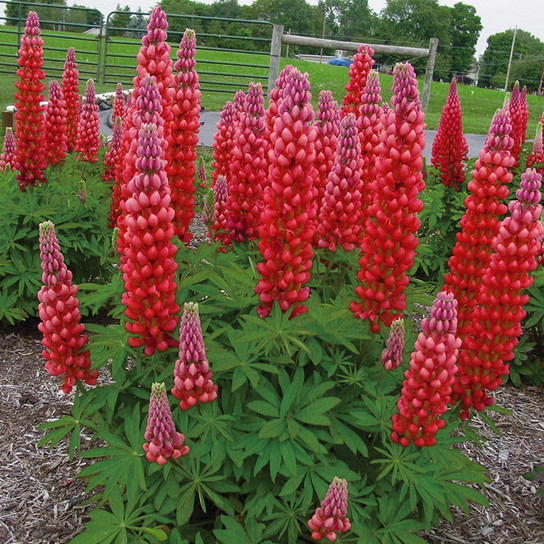
Lupine
Uses:
- Cut Flowers
- Wildlife Gardens
- Thriller in Containers
Features:
- Native to North America
- Attracts Birds, Butterflies & Hummingbirds
- Deer Resistant & Salt Tolerant
Sunlight:
- Partial Sun to Full Sun
- 5+ Hours of Direct Sun
Growing Zones:
- 3-9
- What is My Zone?
Lupine is an easy to care for plant that is Native to North America. The striking upright flowers and textured foliage provide unique interest to any garden!
Why Buy Lupine Online?
Lupinus is a large genus of flowering plants in the legume family, comprising hundreds of species. Featuring pea-like flowers in white, pink, red, yellow, blue, purple, or bicolor, you can’t go wrong with this ornamental. It grows 1-3 feet tall, and the foliage is grey-green with silvery hairs. We offer lupine because it adds color to a garden, self-sows, and is deer resistant. Lupine can be toxic to humans and animals.
Use in a wildlife garden or mixed bed
Blooms in many colors
Unique flowers available in several colors
Typically grow 1-3 feet tall
Growing zones 4 to 8
About Lupine

Lupin, bluebonnet
Western United States
Perennials
Herbaceous
4-9
White, pink, red, yellow, blue, purple
Spring to summer
Rounded
Butterflies, mason bees, bumble bees, and hummingbirds
Drought
Deer
How To Use Lupine In The Garden
Lupines, belonging to the genus Lupinus, are notable for their tall, cone-shaped flower spikes in red, yellow, white, purple, or blue. These blooms often exhibit bicolored patterns and attract pollinators such as bees and butterflies. Hardy in USDA zones 4 through 8, lupines thrive in full sun and cooler temperatures, reaching heights between 1 to 5 feet. Their unique ability to fix nitrogen from the atmosphere allows them to enhance soil fertility, benefiting surrounding plants.
Lupines serve as striking focal points in mass plantings, cottage gardens, and wildlife habitats. Their towering flower spikes introduce vertical interest, complementing lower-growing perennials. These flowering perennials are efficient in luring pollinators and can be a host plant for native butterflies. Their capacity to improve soil nitrogen levels makes them valuable companions in vegetable gardens, supporting the growth of nitrogen-loving plants.
Lupine Care
Plant lupines in early spring, selecting a site with full sun and well-draining soil. Loosen compacted or clay-rich earth by incorporating compost to enhance drainage. Maintain evenly moist soil during the initial growth phase; once established, lupines tolerate drier conditions, requiring watering primarily during droughts. Fertilization is generally unnecessary, as lupines fix atmospheric nitrogen; however, incorporating compost at planting can promote healthy growth.
Deadhead spent flowers to encourage a second bloom and prevent seed pod formation, as lupine seeds can be toxic. In late fall, after foliage has yellowed, cut plants back to the ground to prepare for dormancy. For winter protection, especially in colder climates, apply a thick layer of mulch over the root zone to insulate against temperature fluctuations. When growing lupines in containers, choose deep pots to accommodate their long taproots and water regularly, as potted plants may dry out faster than those in the ground.
Learn More About Lupine Care

Lupine Companion Plants
Plants that go well with Lupine are deer resistant varieties and early spring bloomers. For a spectacular colorful display, we recommend these plants for your garden area.






























